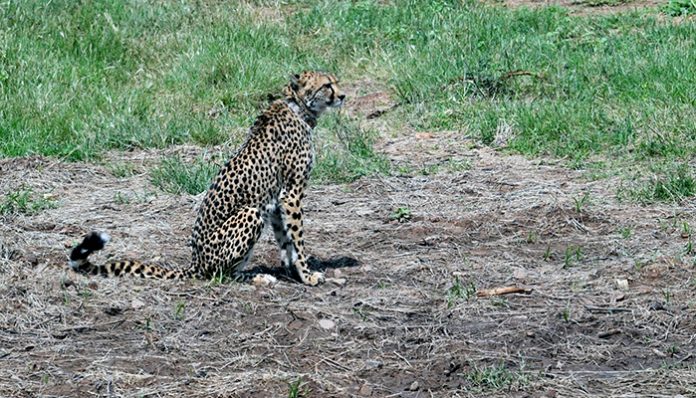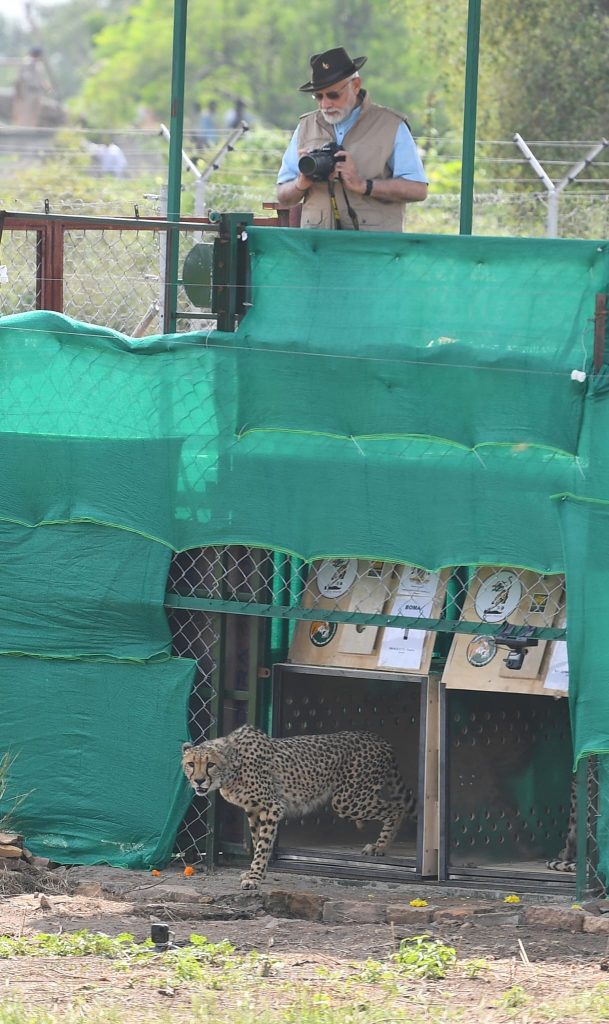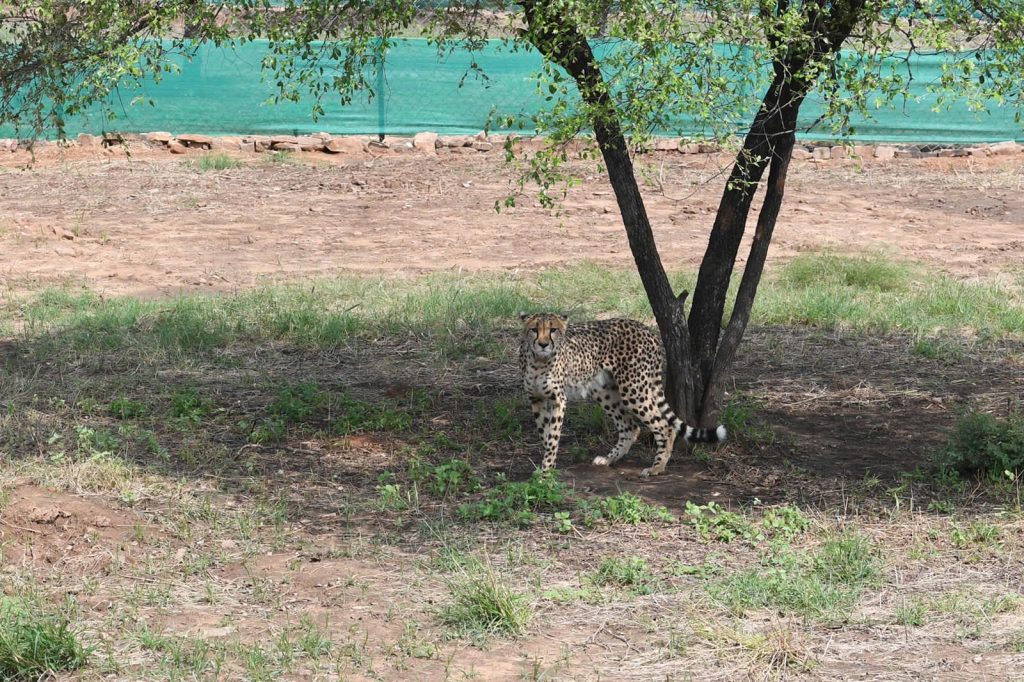By Siva Parameswaran
After clearance from the Supreme court of India and tactful diplomatic efforts, 8 Cheetahs from the South African country Namibia arrived in India on Saturday (17) last and were released into the wild.
The expectations from wildlife enthusiasts and conservation activists were very high and it was a Royal welcome that even said had similarities with visiting heads of State, which made Naturalists like Himanshu Rathore elated. The welcome was marked by the presence of the Prime Minister of India Narendra Modi who received and released them into a special temporary enclosure on his birthday.
Never in India’s history, has such a reception been accorded to any wildlife arriving in the country.
The Cheetahs from Namibia landed in style to a warm welcome amidst mild drizzles after a downpour a couple of days before. As the specially chartered aircraft painted with a Cheetah face touched down at the Gwalior airport a traditional water shower welcome was offered, and the felines were received by the Indian Airforce authorities to be transported in their helicopters to their new homes in the central Indian state of Madhya Pradesh (MP). The federal aviation minister and a scion of the royal family of Gwalior too were present in what the Indian government calls a milestone in wildlife conservation.
Wildlife diplomacy
Considered yet another milestone in Indo-African diplomacy, the cheetahs were translocated from Namibia to the Kuno national park in MP. And, for the first time ever, such an intercontinental translocation of wildlife has happened bringing with it huge challenges for the cheetahs as well as its conservationists.
People like Himanshu Rathore-A wildlife enthusiast/tour leader, Naturalist, and national level skeet shooter are overjoyed and optimistic about the arrival of five female and three male cheetahs from the African Savannah to the Indian grasslands.
“I am very excited about the reintroduction of the Cheetahs like most wildlife enthusiasts would be. We have a very efficient team of conservationists and animal relocation experts who have done enough analysis of the Kuno park and have found it suitable for their relocation. I think these 8 cheetahs would settle well and their number will start increasing”.
At the same time, he says his optimism comes with a caution that a decade of diplomacy, dedication, and determination should not get derailed.
The intercontinental translocation of the Cheetahs though widely welcomed has pragmatic challenges too. Although similarities in conditions and topography with Namibia exist in Kuno National Park, adaptability could be a cause for worry. However, the state and Federal authorities say a decade of planning has gone into it, and ‘all arrangements are in place’ for the big cats to settle.
“However, the lack of enough grasslands which is an ideal habitat for the Cheetah, and as suggested by some researchers also that there is a lack of prey base for them are going to be the two biggest challenges for the successful re-location of these cheetahs. Having said that I am still hoping for the best and looking forward to seeing them in the wild soon” says Himanshu Rathore.
plenty before extinct
Cheetahs became extinct more than 70 years ago in India and as part of India’s wildlife conservation programme the re-location of the fastest animal on the land from Namibia and South Africa was taken forward according to officials. In the first phase, plans were made to receive 20 Cheetahs from Africa. While the initial batch of 8 from Namibia have reached their new home, clearance from the South African government is awaited.
“The protocol from our end is over and we are awaiting the approval from Pretoria” a senior government official told this writer.
Once the dozen more cheetahs arrive from the land of Nelson Mandela, experts say India should look at re-introducing them in more areas like the desert national park in the North Indian state of Rajasthan, which is also home to the renowned Ranthambore National Park Tiger sanctuary-which is showcased as a ‘classic conservation effort’ covering over 1300 sq. km which has contributed to a significant increase in the tiger population in India.
Cave paintings in MP from the Neolithic period indicate that cheetahs roamed around freely in large numbers in central India. Indian historians also claim that the name cheetah originated from their classic language Sanskrit.
While ample proof suggests that cheetahs existed in large numbers covering almost a third of undivided India, overhunting due to the extravagant lifestyle of the Maharajas and then by the British during their colonial rule led to their extinction.
Distinguished wildlife experts like Dr. A J T John Singh former director of the Wildlife Institute of India told this author earlier, that conservation efforts and careful planning apart another major reason for the extinction of cheetahs in India is the loss of its grassland forest habitat accompanied by its comparatively narrow base of their prey.
After Independence feeding a huge population was of huge priority to the Indian government and agricultural production was promoted on a large scale with long-term projects which led to the ‘green revolution making the nation self-sufficient in food production. Huge swathes of forest land were converted for agricultural purposes which deprived the big cats of their prey base leading to their dwindling numbers and eventually the extinction of the cheetah.
Subsequently, there was a shift in the policy of parallelly supporting wildlife along with agriculture production that led to the establishment of specific natural parks for Tigers, Rhinos, and Lions among others.
Indian forest officials say, “the vision behind the intercontinental translocation of the cheetahs is to restore India’s historic evolutionary balance and develop a cheetah metapopulation with a view to conserve the fastest land animal globally”.
Officials are pinning their hopes on the success of the ‘Project Tiger’ which has not only increased the Tiger population significantly but also doubled up the conservation of water bodies coupled with enhanced livelihood of the people dwelling near the forests. Having that as a blueprint forest authorities hope they could replicate the same with the cheetahs.
win-win situation
Dr. Laurie Marker, Executive Director of the Cheetah Conservation Fund headquartered in Namibia says, “the translocation of the cheetahs to India has also been useful in the conservation efforts in Africa too, particularly in South Africa”. Alarmed at the dwindling rate of their population, an intensive conservation programme was implemented in South Africa, which saw considerable growth in their numbers.
Half of the world’s cheetah population thrives in South Africa. As their steadily increase translocating more of them from there would become even more possible. An increase in Cheetah numbers must be compatible with a sufficient prey base for them to hunt and that has its own cyclic effect. So, the success of the present intercontinental transfer of the cheetahs would become a trendsetter in relocating big cats globally.
Indian High Commissioner in Namibia Prashant Agarwal in a statement prior to the cats leaving their motherland said “This a global first. This intercontinental translocation is the first of its kind, with no parallels ever. The reintroduction has a special significance as India marks its 75th independence anniversary this year”.
The 8 African cheetahs have not yet been fully released into the wild. As part of their acclimatization, they have been just released into a special enclosure of around 5 sq. km and are planned to be let into the natural reserve area gradually over a month.
But for people like Himanshu Rathore, one month seems to be a long period, and they are already getting ready with their cameras and jungle boots.
“Ideally had we been able to bring the rare Asiatic Cheetahs back it would be icing on the cake, but I am sure these African cheetahs will also thrive in our forests and grasslands” Looking forward to you in Kuno the Rathore’s told me as I end my chat with them.




